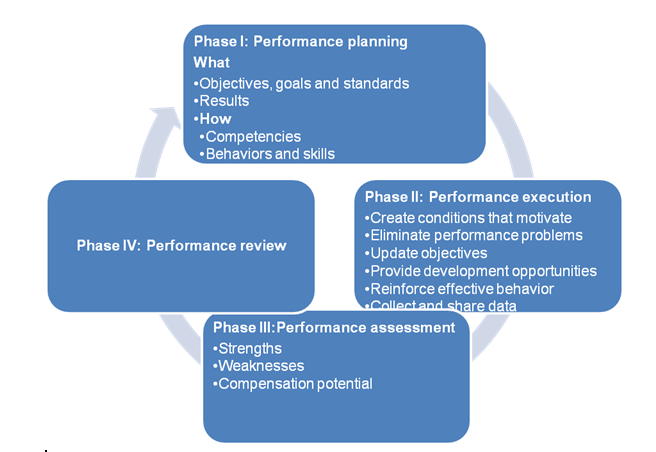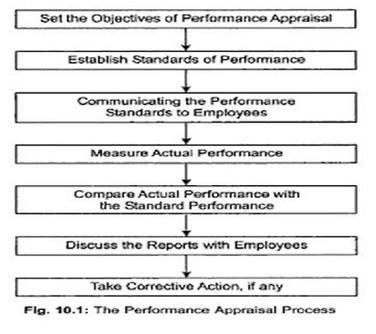Introduction
To attain high competitive advantage in an extremely dynamic environment, it is imperative for organizations to integrate effective management tools. One of the areas that organization management teams should focus on relates to improving their human capital.
In order to attain this, organizations should formulate strategies aimed at influencing the employee’s work lives and careers (Grote 15). Performance appraisal is one of the most effective management instruments that firms can integrate in their effort to influence the employees energy in order to achieve their strategic goals.
This arises from the fact that if well implemented, performance appraisal enables employees to be focused towards organizational values, mission and vision. In this paper, the concept of performance appraisal is comprehensively evaluated.
Meaning and definition
Performance appraisal refers to a formal management system that is used by organizations in the evaluation of individual employee performance. Performance appraisal can be defined as the systematic, impartial and periodic rating of the employees’ on the basis of their present and potential excellence in their job.
Alternatively performance appraisal can also be defined as the quantitative and qualitative aspect of evaluating the employees’ behavior (Chandramohan 124).
In most cases, it is the employees’ immediate supervisors who are charged with the responsibility of preparing the appraisal form used in evaluating the employees’ performance. The appraisal form usually contains a number of questions that assesses the employee performance on different dimensions.
Origin of the topic
The concept of performance appraisal was first conceived in the United States in 1813 by General Lewis Cass. However, the performance appraisal was formally introduced by Taylor & Lord, a New York City department store in 914.
Prior to WWI, most organizations evaluated their employees’ on the basis of personality and traits rather than their accomplishments (Grote 2). However, after the First World War, businesses adopted divergent merit systems in an effort to evaluate their performance.
The past decades have been characterized by incorporation of diverse systems of evaluating the employee’s performance. During the 1950s, Peter Drucker introduced the concept of Management by Objective (MBO). Additionally, Douglas McGregor developed the concept of Theory X and Y.
As a result, most organizations shifted from trait assessment and formulated evaluation procedures that were based on goals. Over the years, the concept of performance appraisal has undergone significant development (Grote 3).
According to Grote (3), approximately 75% -90% of all organizations have formulated a formal performance appraisal procedure. Currently, it is generally accepted that the one of the most effective way of measuring the employees’ performance is by evaluating their results and behaviors.
Importance of the topic to managers/ organizations
Performance appraisal has increasingly been regarded as an indispensable management tool. This arises from the fact that there are numerous benefits associated with performance appraisal to both managers and organizations (Chandramohan 124).
Through performance appraisal, managers are able to make effective decisions with regard to different personnel aspects. According to Chandramohan (124), performance appraisal serves four main purposes. These relate to developmental purpose, organizational maintenance, administrative purposes and documentation purposes.
With regard to developmental purpose, performance appraisal enables organizations to focus on their employees’ development through integration of strategies such as competency development initiatives and training. The resultant effect is that organizations are able to enhance their employees’ future performance which contributes towards their career path.
Performance appraisal enables organizations to attain this through provision of performance feedback. According to Bhattacharyya (57), the feedback provided forms the basis upon which the employee improves his or her future performance.
Additionally, managers can assess the employees’ strengths and weaknesses thus becoming more aware of areas to focus when formulating the training and development program (Snell & Bohlander 347). The resultant effect is that they are able to improve the employees’ productivity.
By evaluating the employees’ performance, firms’ management teams can be able to develop an effective reward system. For example, organizations are able to make effective promotion decisions based on the employees’ capabilities.
Performance appraisal results into improvement of management/subordinate relationship. This arises from the fact that increases the rate of interaction between the employees and the management team.
Performance appraisal is one of the management tools that managers rely in the process of executing various human resource management roles such as staffing.
For example, some situations such as economic realities may force organizations to undertake downsizing. During this process, managers rely on performance appraisal to ensure that they only retrench marginal performance and retain the most talented employees (Grote 5).
According to Snell and Bohlander (347), the data obtained by conducting performance appraisal can be used to undertake human resource planning such as determining job worth. Additionally, the data can also be used to validate selection tests.
Organizations also use performance appraisal to document human resource management actions that can lead to legal actions. Different governments have formulated directives aimed at ensuring affirmative action and equal employment opportunities within organizations.
To protect themselves from possible legal actions for example on the basis of discrimination, it has become imperative for organizations to maintain accurate employee records. Through performance appraisal, organizations are able to attain this (Snell & Bohlander 347).
Review of literature
According to Sims (80), performance appraisal entails the process through which organizations assess their employees’ contribution towards the organization after a specific period. Different terms have been used to describe performance appraisal.
Some of these include performance review, performance evaluation, employee evaluation, annual review and employee appraisal. According to Harvard Business School (4), performance appraisal is a system that is used to support organizational employees in their on-the-job performance.
Traditionally, the threat of punishment and economic rewards in order to motivate the employees to achieve the formulated organizational goals formed the basis of performance appraisal. However, currently performance appraisal is undertaken for motivational and developmental processes.
Additionally, performance appraisal should be considered as a dynamic process which is aimed at improving the organization’s performance. As a result, the process of performance appraisal should be an considered as an ongoing process and not an annual process.
Grote (1) asserts that the process of performance appraisal should follow a 4-phase model which includes performance planning, performance execution, performance assessment and performance review. The chart below illustrates these four phases.

Source: (Grote 3)
Bhattacharyya (54) is of the opinion that performance appraisal is one of the most important elements of performance management. It is not possible to conduct performance management without integrating performance appraisal.
The chart below illustrates performance appraisal as an element of performance management. Performance appraisal enables organizations to understand their position with regard to performance relative to that of their competitors.
Considering the dynamic nature of environment within organizations operate, it has become imperative for organizations to incorporate the concept of performance appraisal in their effort to attain employee performances and management goals.
Through performance appraisal, organizations are able to develop and sustain their competitive advantage. Performance appraisal takes diverse forms such as formal or informal, open or confidential and oral or documented. In their operation, organizations adopt formal and documented systems of performance appraisals (Sims 80).
Bhattacharyya (55) is of the opinion that the process of performance appraisal contributes towards improvement in the level of performance both at the organizational and individual level. However, in order to attain these benefits, it is paramount for organizations to develop effective performance appraisal systems.
For example, a particular performance appraisal system that contributes to some of the employees being rewarded while the others are left out may increase the level of de-motivation.
In the process of designing a performance appraisal system, firms’ management teams should ensure that they take into consideration more than one objective. The appraisal system should focus on issues such as rewards, promotion, employee development and mentoring and development.
Discussion
To effectively conduct performance appraisal, management teams should consider a number of steps. The first step entails establishing performance standards by writing down the job description. The second step entails communicating the standards to all the employees so as to ensure that they understand the basis of the performance appraisal.
The third step involves actual measurement of the employees’ performance. During this step, it is important for firms to undertake short term reviews rather than annual reviews. The fourth step involves comparing the employees’ performance with the established job standards.
The next step entails discussing the results of the appraisal process with the employees. Finally, the managers should rely on the findings to initiate the necessary collective actions (Bhattacharyya 55). The chart below illustrates the process of performance appraisal.

Source: (Bhattacharyya 59).
When conducting performance appraisal, effective techniques should be used. There are different appraisal techniques suggested by scholars. Some of these include peers, subordinates, supervisors, customers and self-appraisal. Organizations should select appraisal techniques that best fit their needs.
However, more than one appraisal methods should be incorporated in order to improve the validity and reliability of the results. An example of performance appraisal system that should be taken into account is the 360-degree. This system enables organizations to collect information about the employee from different sources such as from colleagues, direct reports, suppliers, customers and team members (Shaw 23).
Conclusion
Performance appraisal is one of the oldest concepts in management. Over the years, the concept of performance appraisal has undergone significant development. For example, it has shifted from being based on personality and traits to goals. Currently performance appraisal is also conducted on the basis of results.
From the above analysis, it is evident that performance appraisal is one of the most important management activity. If well implemented, performance appraisal can benefit both employees and the organization.
Through performance appraisal, organization management teams are able make effective decisions with regard to various personnel aspects. For example, they are able to formulate effective employee training and development programs, formulate reward systems, and undertake HR planning.
Through performance appraisal, organizations are able to formulate and implement effective employee motivation strategies thus increasing their productivity. The resultant effect is that the effectiveness with which the organizations attain their goals is increased.
On the other hand, performance appraisal enables employees to attain their personal and professional development goals. This is due to the fact that it enables employees to understand their strengths and weaknesses.
Additionally, the training programs implemented by organizations enhance their career paths. However, attainment of the above benefits is dependent on the effectiveness with which organizations have implemented the performance appraisal system.
As a result, the above steps should be taken into account when conducting performance appraisal. Additionally, the most appropriate performance appraisal technique should be used.
Works Cited
Bhattacharyya, Dipak. Performance management systems and strategies, Sydney: Pearson Education India, n.d. Print.
Grote, Richard. Performance appraisal question and answer book: A survival guide for managers, New York: American Management Association, 2002. Print.
Harvard Business School. Performance appraisal: Expert solutions to everyday challenges, London: Pocket Mentor Series, 2009. Print.
Shaw, Douglas. Performance measurement, management and appraisal sourcebook, Amherst, Mass.: Human Resource Development Press, 1995. Print.
Sims, Ronald. Managing organizational behavior, Westport, CT: Quorum Books, 2002. Print.
Snell, Scott and Bohlander, George. Managing human resources, New York: South-Western Publishers, 2012. Print.